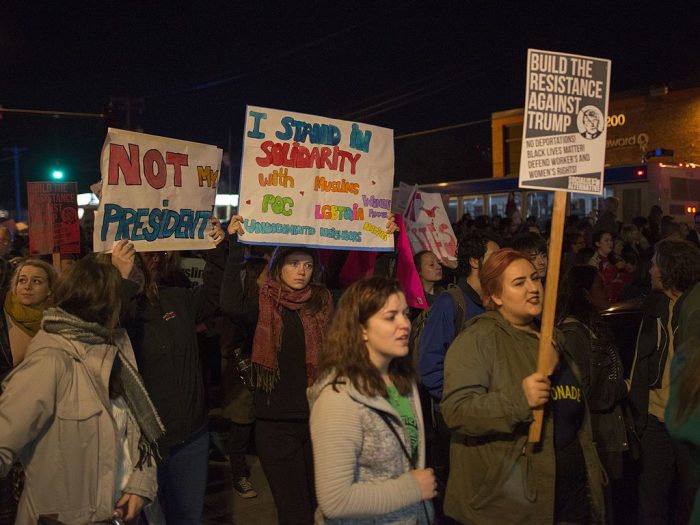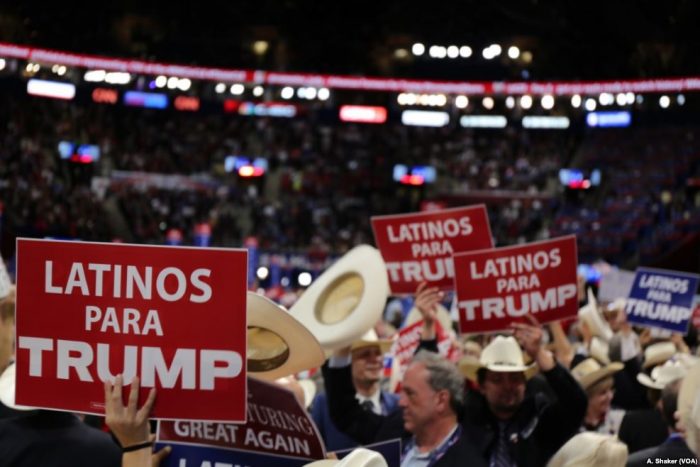The country’s Latino population “is growing, young, increasingly educated, employed, connected, entrepreneurial, and upwardly mobile in terms of income as well as consumption,” read a recent report by NERA Economic Consulting, along with support from the Latino Donor Collaborative and the Royal Bank of Canada.
Titled “Making America Rich Again,” the publication presented a halcyon future where young Latinos’ economic success will embody the American dream. In an attempt to devoid himself from conflicting interest with President Donald Trump, economist and author of the report, Jeffrey A. Eisenach, said “The study is completely separate from my relationship with Trump. I embarked on this as an economist.”
Eisenach’s claim is admirable, but it’s fallacious. No scholar, no matter how objective they seek to be, is uninfluenced by contemporary concerns. The report is currently one out of several studies conducted to combat President Trump’s anti-immigration sentiment.
To completely believe these studies, particularly one titled “Making America Rich Again,” would just be injudicious.
Yet no matter how many studies like these emerge, nor the frequent reports on soon-to-be-deported undocumented immigrants who contradict Trump’s claim of removing “really bad dudes” from the country, Latinos in disadvantaged communities like Springfield, Massachusetts’s North End section will remain impoverished, as they have been before Trump’s election.
About 153,000 residents live in Springfield. Latinos, who are overwhelming Puerto Rican, make up 38 percent of the population and are largely concentrated in the city’s deindustrialized north side. As of 2015, Latinos have one of the highest poverty and unemployment rates at 45.4 and 17 percent, respectively. They also have the lowest labor-participation rate at 55 percent. About one-third of Latinos in the city lack a high school diploma. From 2003 to 2013, the city hovered between fifth and third place for metropolitan areas with the highest rate of concentrated poverty for Latinos. Springfield’s school district has nine out of the 20 poorest schools in the state. These issues are unlikely to change after Trump leaves the White House, even with the most optimistic predictions.
Trump’s election has facilitated a debate among Latino business leaders, journalists and politicians on whether Latinos should resist Trump or cooperate with him. Some have seen his economic policies as beneficial to Latinos’ aspiration for entrepreneurship while others have viewed Trump’s myths about immigrant criminality as harmful to the community.
While this debate is necessary, it fails to include those who live on the margins. Those who marginalization isn’t tied to the immigration system. Whose plight contradict sanitized images produced by groups likeNERA Economic Consulting. A segment of the population whose situation won’t change—no matter how many Latino-owned businesses emerged.
Exclusively focusing on Trump, whether it’s working with him or resisting his policies, risks creating tunnel vision. While some journalists and advocates have noted the intersectionality of immigration with issues such as mass incarceration and police harassment, they must also acknowledge that not every issue that affects Latinos is tied to immigration.
In fact, continuously fighting against Trump and what he stands for as an individual might sideline pressing issues that plague communities like Springfield.
It also risks creating a politics National Institute for Latino Policy founder Angelo Falcón described as “focused on documenting that Latinos are ‘more American than the Americans themselves’ to the point that the impression given is that every undocumented Central and South American teenager in the country is at the very least a high school valedictorian!” Whether this sort of politics Falcón described persist all depends on how some advocates want to portray Latino politics. While the issues are too numerous to list, one pressing issue that demands immediate attention is concentrated poverty.
Urbanists have labeled concentrated poverty as the “new urban panic.” Communities where 40 percent or more of residents live in poverty has increased in American small and mid-size cities at the fastest rate. Today, poor people are more likely to live in high impoverished areas than they were 50 years ago. Latinos are three times more likely than poor Whites to live in an extremely high-poverty neighborhood. In an op-ed for Al Jazeera America, University of South Florida anthropologist Susan Greenbaum noted in these neighborhoods poor people have “underfunded schools, overly aggressive police, substandard housing, inadequate health care, exploitative businesses, paternalistic or corrupt services, few legal job possibilities and too much crime.”
While the topic has received much attention from urban analysts, it has been largely absent in the dialogue about major issues facing the Latino community. Historical and contemporary stereotypical images of Latinos as poverty-stricken makes it difficult to talk about an issue like concentrated poverty. Some activists who wish to downplay the issue might dismiss it as a result of immigration. But not all immigrant communities are poor. In fact, six out of the 10 metropolitan areas with the highest rates of concentrated poverty are Puerto Rican communities in the Northeast and Midwest, where many are third- and fourth-generation migrants.
As a collective group, the Latino poverty rate is slightly lower than the rate for African Americans; however, when examining particular subgroups, there’s virtually little difference. According to Pew, as of 2013, Mexican Americans, Guatemalans, Puerto Ricans, and Dominicans had a poverty rate of 25 percent or higher. Peruvians and Argentineans had the lowest at 13 and 11 percent, respectively. South Americans and Cubans also have a lower child poverty rate than other groups. To those knowledgeable about these differences, these statistics are unsurprising. But they are rarely cited in many recent reports on Latinos that provide an upward-mobile image.
Puerto Ricans stand out significantly when using disaggregated data. In 2016, the Center for Puerto Rican Studies issued a report on the status of Puerto Ricans in Puerto Rico, the United States and in selected states as of 2014. Stateside Puerto Rican poverty and unemployment rates was 26.2 and 11.6 percent, respectively. That is higher than the Latino aggregate, where poverty and unemployment stood at 21.4 and 6.7 percent, respectively, as of 2015. While Puerto Ricans in the Southeast and in the West are well-off economically, their counterparts in the Northeast and Midwest faced significant challenges. Here are two tables that consist of state-level data on poverty and unemployment rates for Puerto Ricans and Latinos:
| Puerto Ricans Poverty & Unemployment Rates, 2014 | |||
| State | Population | Poverty Rate | Unemployment Rate |
| Connecticut | 301,182 | 33.1% | 14.8% |
| Massachusetts | 308,028 | 38.6% | 16.5% |
| New York | 1,100,000 | 29.2% | 12.2% |
| Ohio | 108,174 | 33.3% | 13% |
| Pennsylvania | 423,755 | 36.8% | 17% |
| Rhode Island* | 36,217 | 51.3% | 24.2% |
*Rhode Island is from 2013
Numbers from the Center for Puerto Rican Studies, 2014
| Latino Poverty & Unemployment Rates, 2014 | |||
| State | Population | Poverty Rate | Unemployment Rate* |
| Connecticut | 540,000 | 27.6% | 11.3% |
| Massachusetts | 729,000 | 30.9% | 11% |
| New York | 3,668,000 | 26.7% | 6.7% |
| Ohio | 395,000 | 29.6% | 5.8% |
| Pennsylvania | 834,000 | 33.5% | 7.7% |
| Rhode Island | 148,000 | 33% | 9.1 |
Demographic profile of Hispanics 2014, Pew Research Center, Hispanic Trends
Poverty rates from American Community Survey, 2014
*Unemployment data from Bureau of Labor Statistics, 2015, latest numbers
All of these statistics on Puerto Ricans are higher than the Latino aggregate. They are also the highest in the state among all racial and ethnic groups. If not for the Center for Puerto Rican Studies, this data would have remained hidden.
It’s tempting to argue that immigration sidelines other issues, and the election of Donald Trump has strengthened this argument. But this is an inaccurate portrayal of Latino politics. It perpetuates the perception that Latinos are single-issue focused. While it’s understandable that some advocates want to only focus on positive news stories about Latinos in the Age of Trump, is it possible to acknowledge immigrants’ contribution to the country, while noting that not all problems in the community are related to recent arrival status? We cannot have an informed discussion about concentrated poverty and other issues without addressing the historical and contemporary forces that created them.
Springfield isn’t the only community likely to remain unchanged from systemic problems during Trump’s presidency. Other impoverished neighborhoods such as Back of the Yards in Chicago, Fairhill in Philadelphia, Roxbury in Boston, and the south side of Stockton, California, will probably see little improvement as well. To sideline these communities and others like them to focus on a president who possesses the vocabulary of a third grader will do a disservice to those whose situation will remain unchanged no matter who occupies the White House.
***
Originally from Allentown, Pennsylvania, Aaron G. Fountain, Jr. is a Ph.D. student in the Department of History at Indiana University-Bloomington. Twitter: @aaronfountainjr




